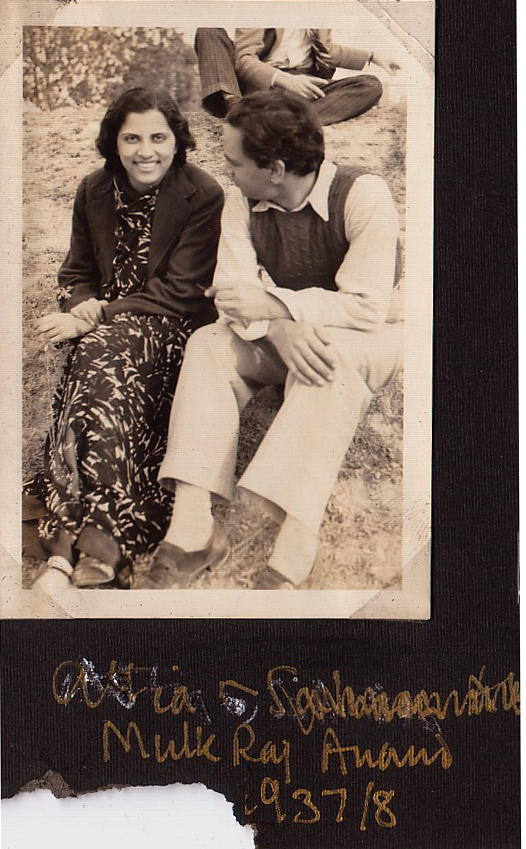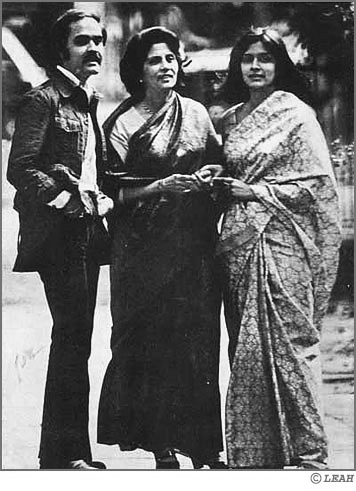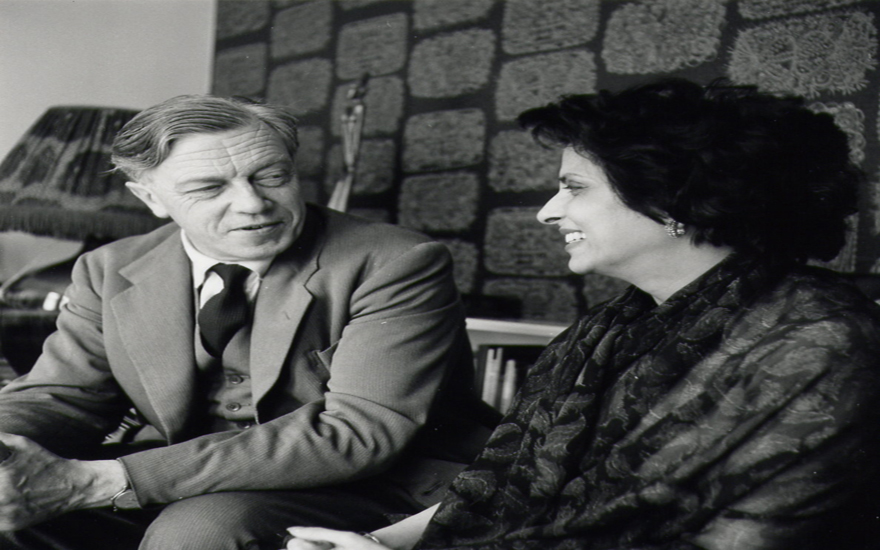A Woman for all Seasons
By Muneeza Shamsie | Profile | Published 10 years ago
This October marked the birth centenary of Attia Hosain (1913-1998), one of the earliest women writers of South Asian English fiction and the well-known author of Phoenix Fled (1953) and Sunlight on a Broken Column (1961). To mark the occasion, commemorative events were held in London and a new book, Attia Hosain: Distant Traveller: New and Selected Fiction, was launched. Co-edited by Aamer Hussein and Shama Habibullah, Attia’s daughter, it brings to light several hitherto unpublished stories, including the beginnings of a novel set in the London, culled from Hosain’s papers. The publisher, Ritu Menon of Women Unlimited, hopes the book will lead to a critical reassessment of Attia’s fiction since “few writers of her generation straddled two cultures as she did and absorbed both into her writing.” The book includes Aamer’s incisive ‘Afterword,’ a literary assessment combined with personal recollections, while Shama’s ‘Foreword’ describes her mother’s transition from a sheltered, privileged life in India, to that of a novelist and broadcaster in post-war Britain.
Attia was born in Lucknow, the daughter of Shaikh Shahid Hussain Kidwai, a Cambridge-educated lawyer, public figure and feudal landlord — a taluqdar of Oudh. He died when Attia was just 11 years old. Attia received a traditional education at home in Urdu, Arabic and Persian, but also learnt English, joined La Martiniere School for Girls and went on to the Isobella Thoburn College, where she was the first woman graduate from a taluqdar family.
Attia longed to go to Cambridge University, as did her brother, but she was not allowed to do so. However, in 1933, she defied tradition to marry of her own choice. This caused great outrage, although her husband, Ali Bahadur ‘Sonny’ Habibullah, was her first cousin; his mother and hers were sisters. He and his two brothers, Enaith and Isha’at (my father), had been sent away to school in England as boys. They returned in the 1930s, as did Sahibzada Mahmuduzzafar Khan, a family friend and a Marxist who had a profound influence on Attia.
In 1946, Attia moved to London because Sonny, a civil servant, was posted to the then new Indian High Commission. While they were there, Partition was announced. Amid the anguish of news from home, the riots, massacres and displacements, the world they had known vanished overnight. Attia stayed on in London. Shama recalls:
“As long as I can remember my mother…was our ‘kissahgoh’, our storyteller. This was particularly important to us as we grew up between two countries and were linked in the course of our lives to several others. Both of us, my brother Waris and I, are filmmakers so her narratives also provided us with the images of our imagination: they became the touchstone to families, people, interests outside ourselves which gave us our own sense of identity. They helped remove us from ‘an absence.’”
In India, Attia had written for newspapers such as The Pioneer and The Statesman. In England, she focused on fiction to reclaim memories of her homeland. This developed into her timeless story collection, titled Phoenix Fled, which remains a particular favourite of mine.

Great minds: Attia with Mulk Raj Anand.
My first conscious memory of Attia dates back to this time. My parents had accompanied me from Karachi to England, where I joined boarding school in Sussex and would stay there for nine years; later, my younger sister Naushaba joined me. In that post-war era, London was pockmarked with dark, sooty half-bombed out buildings and there was still food-rationing. Attia was working for the BBC’s Urdu service. I have memories of Attia and her colleagues, Ijaz Hussain Batalvi and Zia Mohyeddin, poring over scripts in her Sloane Avenue flat, discussing the technicalities of broadcasting and ‘how to throw your voice.’ She had a wonderful voice — even her laughter was pure music — and she played leading roles such as Desdemona in Othello in the Shakespeare plays translated into Urdu by Siddiq Ahmed Siddiqi and broadcast by the BBC’s Eastern Service.

All in the family: Attia with her children, Shama and Waris.
Attia was extraordinarily beautiful. She was named after the fabled Atiya Begum Fyzee Rahamin, a family friend. There used to be a well-known saying, “Come to India to see the Taj Mahal and Attia.” Which one of the two Attia’s it referred to, was a subject of much debate. She was years ahead of her time; she asserted the right to make her own decisions on matters that concerned her most — her marriage, her career and her future. This often placed her at odds with her family and society. She also defied subcontinental taboos surrounding acting and public performance for the well-born woman.
In 1961 she acted in a West End play, The Bird of Time by Peter Mayne, set in a Kashmiri houseboat; her co-stars included Gladys Cooper. I was so excited to see her on stage, dressed in a sari, as always. More importantly, it was the first time that I had seen a subcontinental character performed authentically on the English stage.
Literature, film and theatre were an integral part of Attia’s family life in London. Her son became the well known EMMY and BAFTA-winning director, Waris Hosain; her daughter, Shama Habibullah, was a documentary film maker. Their conversations, on subjects Naushaba and I dared not query, would swirl around us as children. We saw quite a lot of Attia, whenever my parents visited London. My father loved to cook and would prepare a dish or two in Attia’s kitchen. Sometimes they discussed recipes. Attia conjured up wonderful quick meals and co-authored the invaluable Cooking the Indian Way with Sita Pasricha, which I still use. Our summer holidays in Karachi, sometimes included a visit to my dadi in Lucknow. Attia and other family members would come for these reunions — and quarrel over Partition — and I would glimpse remnants of a bygone world, split asunder by modernity, politics and changing times. Attia’s fiction captures this vividly.

Literary giants: Attia Hosain with Cecil Day-Lewis.

In 1961, she published her famous novel Sunlight on a Broken Column, which links a young woman’s struggle for empowerment with India’s struggle for independence. The novel welds a panoramic view of a gracious, glittering culture with a mild critique of social inequities, set against the freedom movement and the widening gap between the Congress and the Muslim League.
Attia’s publisher was Chatto and Windus; her editor was poet Cecil Day-Lewis. Shama mentions that years later, Day-Lewis “put in English verse, based on renderings by Attia, poems by Ghalib, Iqbal, and Bahadur Shah Zafar… sung by Talat Mahmood” for Shama’s first documentary Ashiana, about Lucknow.
Attia greatly enjoyed the company of the young. During her trips to London from Karachi, where I had started to write freelance, I loved to talk to Attia about new books, films, theatre as she would play with my daughters, Saman and Kamila. Kamila says “She was one of the first people to take seriously my declaration of intent to be a writer.” Kamila had wanted to write since childhood and was immensely aware that Attia, a relative, had attained Kamila’s “great dream — publication by a house in the centre of English Literature.”
The 1988 Virago reprints of Phoenix and Sunlight, with an introduction by Anita Desai, brought Attia’s fiction renewed attention. But Attia also kept a private journal, which Shama sorted after Attia died — 1000 pages of diaries, jottings and stories. Shama asked Aamer Hussain, a family friend, to help with a new collection. This became Distant Traveller, which opens with ‘No New Lands, No New Seas,’ the beginnings of an incisive and poetic novel, discovered in a drawer. Markedly different from Attia’s earlier fiction, it is set London in 1972, amid racist tensions. Murad, an Indian, has resolved to return to his native Lucknow. He looks back upon his growing disenchantment with Britain over the years, his friendship with Isa, a Pakistani, and the reverberations of Partition. However, Isa is killed in London in a hate crime. Murad makes a condolence call to Isa’s widow. He thinks of her as “commonplace, uneducated, old fashioned,” but finds she has the will to create a new life for herself in Britain. The story leads up to his conversations with Delhi-born Munnay from Dacca (Dhaka), an ex-factory worker in Britain, now employed in Murad’s favourite restaurant, owned by a Bengali — an indication that perhaps Attia planned to incorporate the 1971 conflict. Certainly, her portrayal of the South Asian diaspora foreshadows the fiction of a younger generation of British Asians.
Distant Traveller includes four hitherto-unpublished stories written with astonishing insight, of life in the 1930s. Among them, ‘The Storm,’ describes a beautiful, intelligent and independent woman, scorned by women socialites at a hill station; while ‘The Leader of Women’ creates a vivid, satirical portrait of a privileged, self-serving woman politician. A later work, ‘The Old Man,’ tells of a rural outpost where the local bureaucrat terrorises a helpless, elderly employee. The book also includes some of the best stories from Phoenix Fled such as ‘The Daughter-in-Law,’ a haunting tale of a traumatised little child-bride; ‘White Leopard,’ where a young aristocrat discovers human qualities in a dacoit; and ‘Phoenix Fled,’ in which an old woman confuses the violence of 1947 with that of 1857.
Attia’s essay ‘Deep Roots’ is a real treat; it discusses the technical challenges of transposing the experience of the subcontinent into English — an issue which South Asian English writers continue to tackle to this day.


